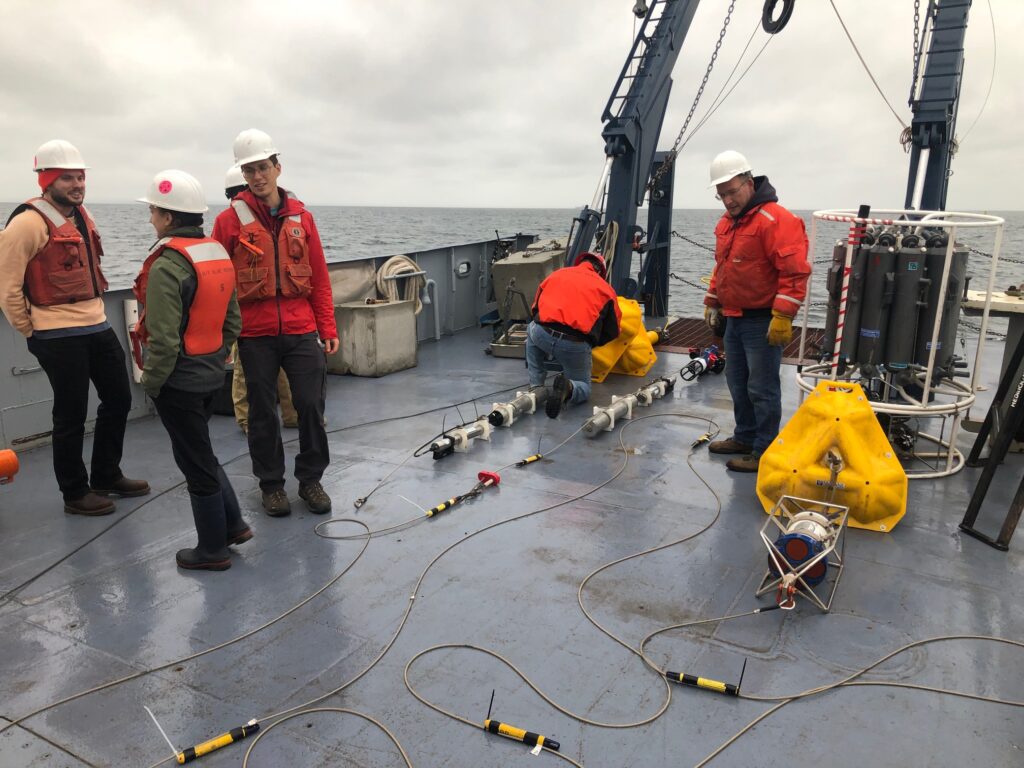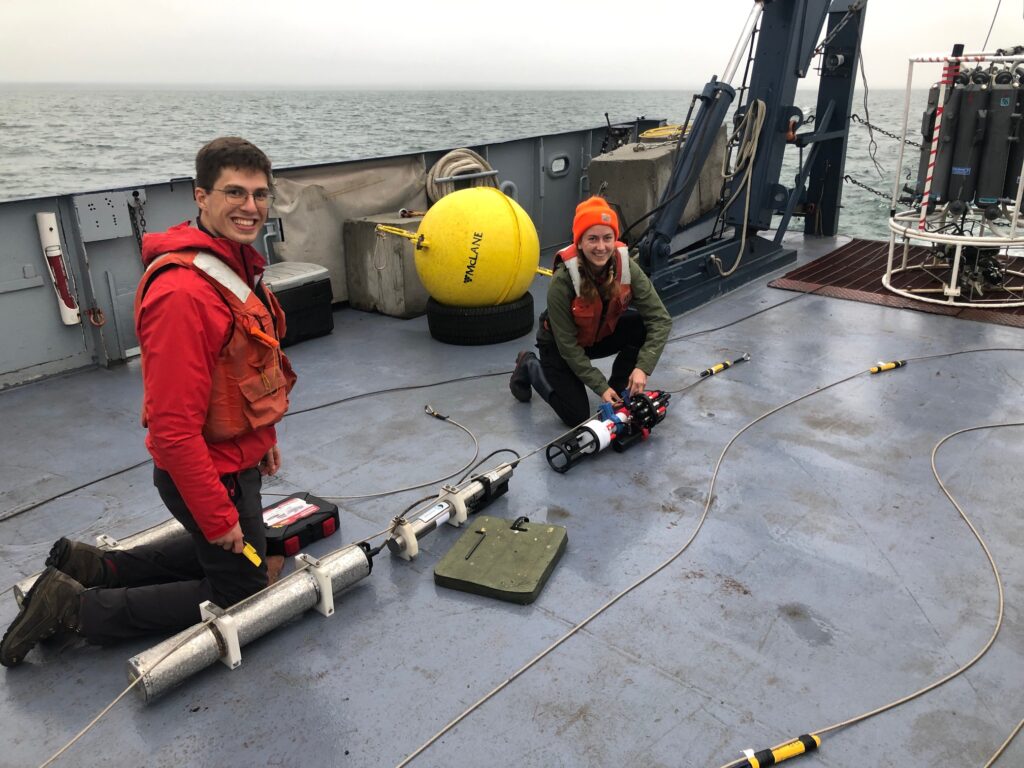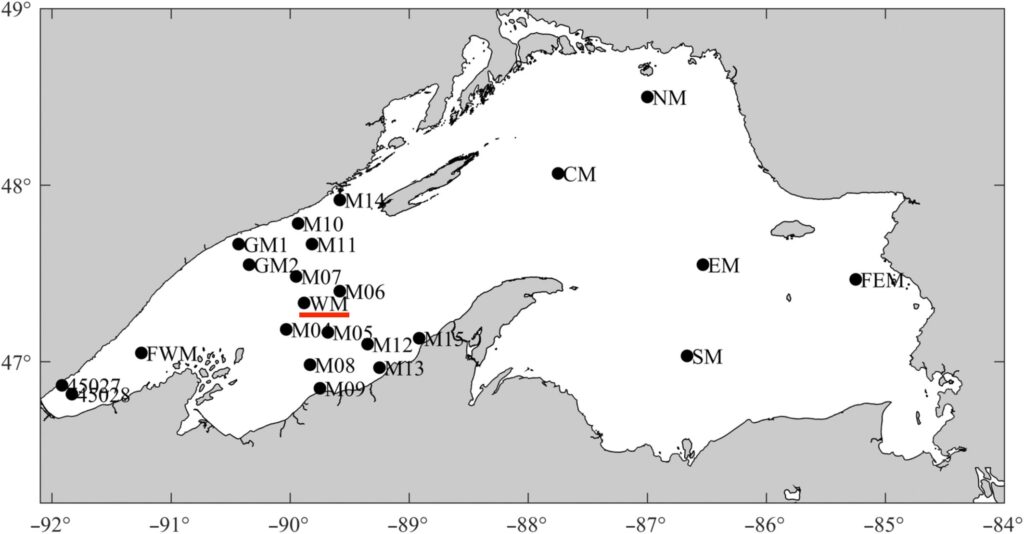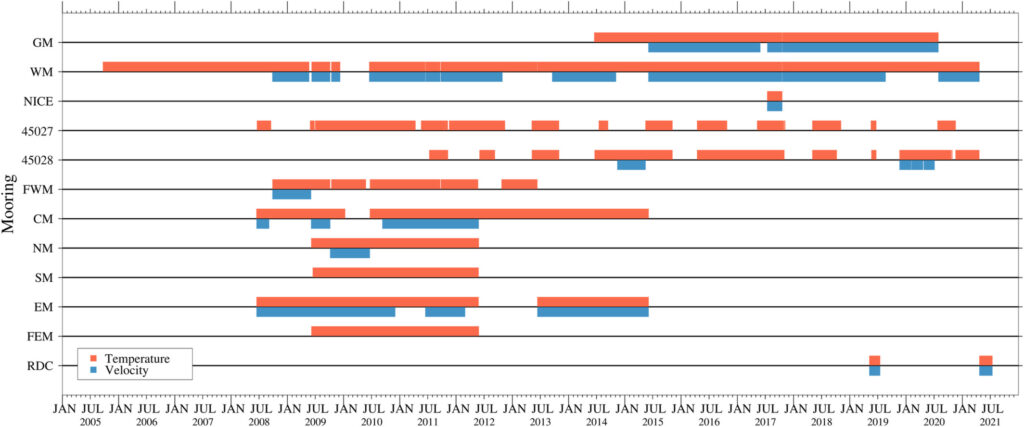
Every year, as the network of Great Lakes meteorology buoys comes off the water, a hole opens up in our understanding of lake conditions.
The threat of violent winter storms, coupled with shifting ice formations and other adverse conditions, makes taking water samples and deploying monitoring platforms, like surface buoys and gliders, difficult or impossible. As a result, during December-April, the monitoring community collects far less data.
The scarcity of year-round data hinders our understanding of lake dynamics and its long-term changes.
Without platforms collecting data, researchers are left wondering about some fundamental drivers of lake health. How is water mixing? What are the nutrient levels? What are temperatures below the surface?

A long-term look
However, several researchers have kept monitoring gear in the water, even in the coldest months.
Jay Austin and colleagues at the University of Minnesota-Duluth’s Large Lakes Observatory have operated year-round subsurface moorings at multiple locations in Lake Superior over the past 17 years.
The UMD moorings collect critical information on the lake’s temperature, chemical composition, and currents in Superior’s cold, deep waters. These measurements can help scientists better understand the warming of the lakes and other effects of climate change.
These moorings usually consist of a spherical steel float, a jacketed steel cable, an acoustic release to facilitate recovery, and a large concrete anchor. Sensors are either attached to the cable or are deployed in steel inline cages.

Starting in 2005, Austin and others at UMD began deploying year-round moorings in Lake Superior. The first of these sites was the Western Mooring (WM), located in the middle of the western half of Superior.
UMD researchers have kept equipment in place at WM nearly continuously since 2005. Several other sites have been occupied for multiple years, including during an NSF-sponsored program from 2008-2012 when up to eight locations were occupied at once, and during an intensive field season in 2017 when 17 locations were occupied simultaneously.
Moorings primarily measured temperature and current at multiple depths, but since these deployments were often collaborative efforts, other researchers frequently added other sensors to the moorings.
During a pilot deployment in 2022, the team deployed a mooring with sensors for traditional parameters like temperature and currents as well as a wide variety of biogeochemically relevant parameters, including:
- pH
- Nitrate
- pCO2
- Dissolved oxygen
- Turbidity, and more.
Austin says that this sort of approach will become more common as biogeochemical sensors drop in cost and capture more parameters.

Unlike surface buoys, these moorings don’t transmit data in real-time, but instead save the data to loggers that can be retrieved with the moorings when the team returns the following season.
For many purposes, including understanding climate-change driven temperature fluctuations, collecting data in near-real time, like most surface buoys do, isn’t necessary, Austin says. Climate change takes place over much longer periods of time.

While UMD operates some of the longest-recording winter monitoring sites, other organizations also collect year-round data. Some projects include:
- The NOAA Great Lakes Environmental Research Laboratory’s (GLERL’s) fixed mooring in the deepest part of the southern basin of Lake Michigan has collected temperature data since 1990. Other GLERL moorings cover shorter timespans in Lakes Huron and Superior.
- Year-round temperature measurements collected at water intakes around the Great Lakes.
In addition, last winter and this winter, dozens of scientists sampled all five lakes during winter grabs. Interest in collecting real-time observations has also driven efforts to deploy low-cost drifters and buoys during the winter season by various organizations like the Great Lakes Research Center at Michigan Technological University and the Cooperative Institute for Great Lakes Research, and to explore real-time data transmission from moorings like the “winter stick” designed by Upstate Freshwater Institute, with support from GLOS.
Understanding the patterns of the always-changing lakes is no easy task. While wind drives surface currents and waves, heating and cooling at the surface result in temperature stratification that evolves throughout the year, leading to a host of other phenomena.
With the water always in flux, the microorganisms and nutrients floating in the water make up an ever-changing mixture that determines where fish and other lake inhabitants can thrive.
And because temperature is such a strong driver of water movement and stratification, Austin makes sure the UMD moorings are well-equipped with temperature sensors, called thermistors. One of Austin’s currently deployed moorings is equipped with 90 thermistors at different depths, offering an exceptionally high-resolution look at temperature dynamics.
“You can ask a different set of questions when you have that resolution,” said Austin.
What’s next?
Right now, anyone can explore this dataset for themselves. All 17 years of data is now available through the University of Minnesota’s data repository here and here.
GLOS is also working with Austin to explore adding the dataset to Seagull, where the data will be more visible to Great Lakes researchers.
With the data public and a paper published in Limnology and Oceanography Letters (Austin and Elmer 2022) Austin says he’s excited for this data to find other uses, and hopes to collaborate with other researchers to dissect the data.
And, as he looks to the future of these long-term moorings, Austin says he hopes that other researchers can continue doing more mooring deployments every year, keeping more sensors in the water.
He also sees an opportunity to overcome one of the biggest challenges in large lake observing: expensive ship time. A single day on a research vessel can cost thousands of dollars. He is currently exploring partnerships that might provide opportunities to save costs and enable researchers to expand mooring networks. With more collaboration, researchers could share more ship time, deploying or recovering multiple observing platforms in a single mission.
The good news is that the community doesn’t have to wait on new technology to make this vision possible.
“This mooring technology is sitting on the shelf. It’s cheap,” he said. “We can wait 10, 15, 20 years for the technology to do real-time, year-round offshore observations to come along, or we can start using off-the-shelf technology right now.”